Broadcom BRCM1087 802.11a/b/g/n/ac WLAN + Bluetooth PCI-E NGFF 2230 Card User Manual FLEX 3 1480 FLEX 3 1580 UG EN
Broadcom Corporation 802.11a/b/g/n/ac WLAN + Bluetooth PCI-E NGFF 2230 Card FLEX 3 1480 FLEX 3 1580 UG EN
Broadcom >
Contents
- 1. Manual
- 2. OEM installation Guide
- 3. Manual 1
- 4. Manual 2
- 5. Manual 3
- 6. User manual
- 7. User Manual_20150824_v1 - BCM94350ZAE Regulatory Notice US&CA
- 8. User Manual_20150824_v1 - BCM94350ZAE User Manual
User Manual_20150824_v1 - BCM94350ZAE User Manual
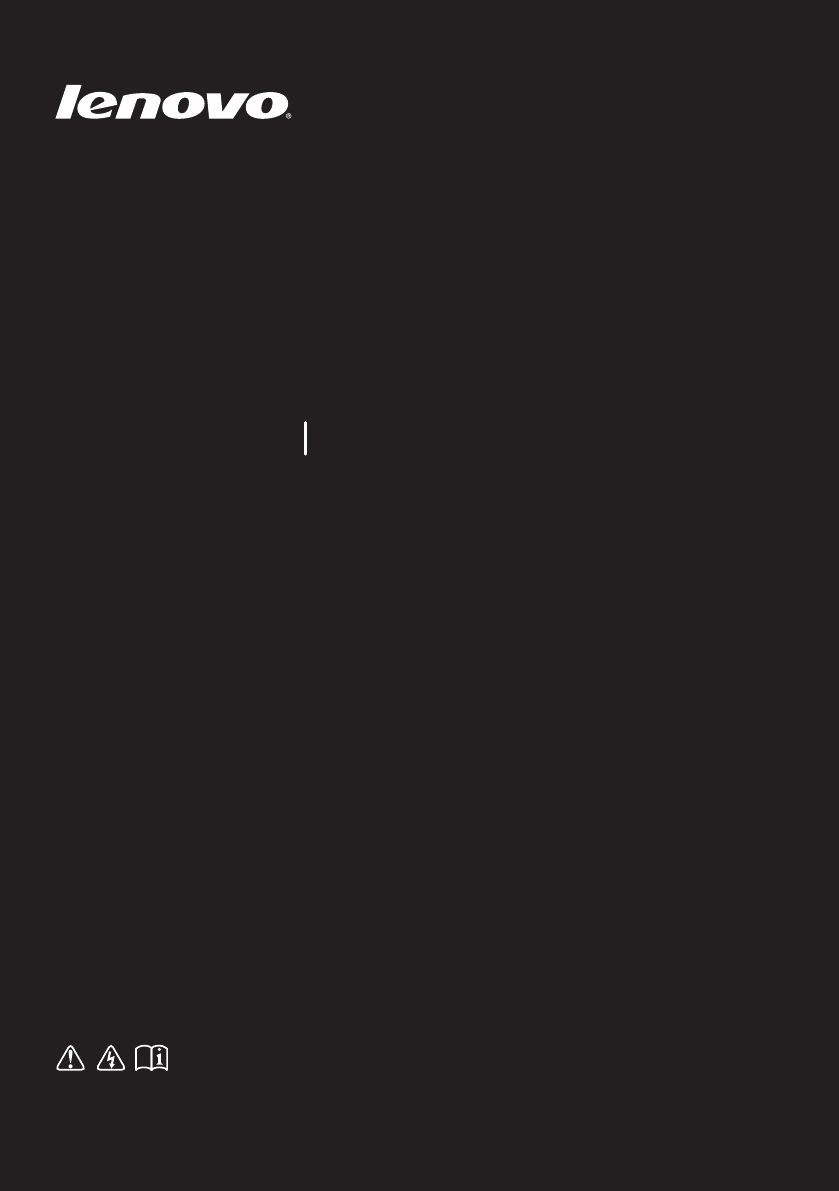
Lenovo FLEX 3
Read the safety notices and important tips in the
included manuals before using your computer.
User Guide
FLEX 3-1480 FLEX 3-1580

First Edition (June 2015)
© Copyright Lenovo 2015.
LIMITED AND RESTRICTED RIGHTS NOTICE: If data or software is delivered pursuant to a General
Services Administration “GSA” contract, use, reproduction, or disclosure is subject to restrictions set
forth in Contract No. GS-35F-05925.
For details, refer to Guides & Manuals at http://support.lenovo.com.
Regulatory Notice
Before using the product, be sure to read Lenovo Safety and General Information Guide first.
The features described in this guide are common to most models. Some features may not
be available on your computer or your computer may include features that are not
described in this user guide.
Some instructions in this guide may assume that you are using Windows® 8.1. If you are
using another Windows operating system, some operations may be slightly different. If
you are using other operating systems, some operations may not apply to you.
Notes
•
•
•
The illustrations used in this manual are for Lenovo FLEX 3-1580 unless otherwise stated.
•
The illustrations in this manual may differ from the actual product. Please refer to the
actual product.
•
•
i
Contents
Chapter 1. Getting to know your computer..................................................................................... 1
Top view ......................................................................................................................................................... 1
Left-side view .............................................................................................................................................. 10
Right-side view ............................................................................................................................................ 13
Bottom view ................................................................................................................................................. 16
Chapter 2. Lenovo OneKey Recovery System.............................................................................. 18
Chapter 3. Troubleshooting............................................................................................................ 19
Frequently asked questions ....................................................................................................................... 19
Troubleshooting .......................................................................................................................................... 21
Trademarks ...................................................................................................................................... 24
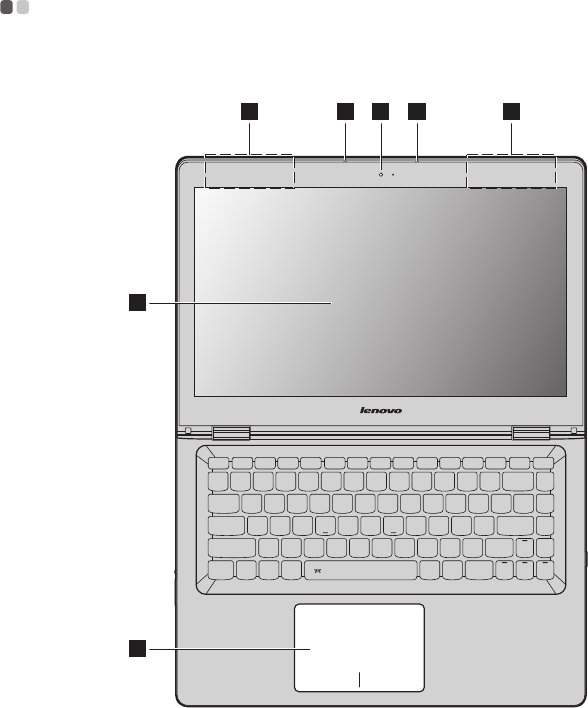
1
Chapter 1. Getting to know your computer
Top view - - - - - - - - - - - - - - - - - - - - - - - - - - - - - - - - - - - - - - - - - - - - - - - - - - - - - - - - - - - - - - - - - - - - - - - - - - - - - - - - - - - - - - - - - - - - - - - - - - - - - - - - - - - - - - - - - - - - - - - - - -
Lenovo FLEX 3-1480
1 33
4
5
22
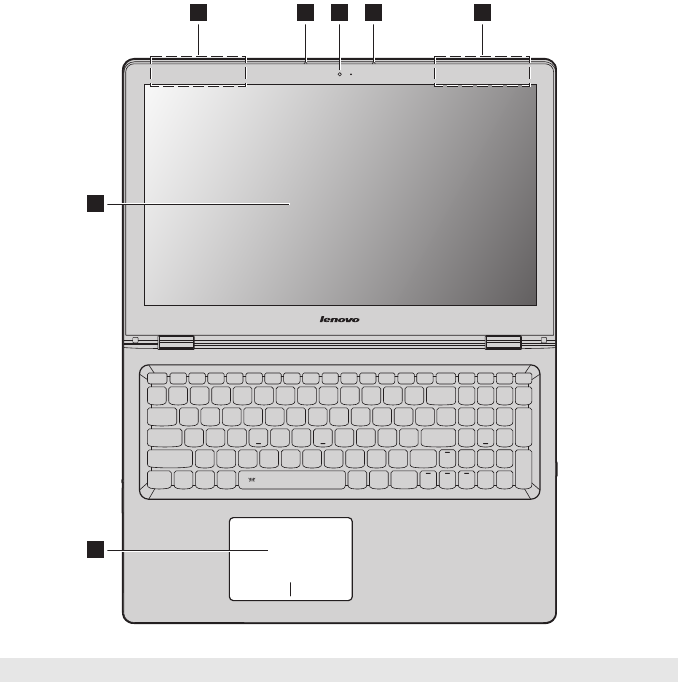
2
Chapter 1. Getting to know your computer
Lenovo FLEX 3-1580
Attention:
•When closing the display panel, be careful not to leave pens or any other objects in between the display
panel and the keyboard. Otherwise, the display panel may be damaged.
Note: The dashed areas indicate parts that are not visible externally.
4
5
1 33 22

Chapter 1. Getting to know your computer
3
aIntegrated camera Use the camera for video communication.
bWireless LAN antennas
Connect to a wireless LAN adapter to send and receive wireless radio signals.
cBuilt-in microphone Captures sound which can be used for video conferencing, voice
narration, or audio recording.
Note: Select models may have only one microphone, please refer to the actual product.
dMulti-touch screen The LCD display with LED backlight provides brilliant visual output.
Multi-touch function is available on this display.
eTouchpad The touchpad functions as a conventional mouse.
Touchpad: To move the pointer on the screen, slide your fingertip over
the pad in the direction in which you want the pointer to move.
Touchpad buttons: The functions of the left/right side correspond to
that of the left/right mouse button on a conventional mouse.
Note: You can enable/disable the touchpad by pressing F6 ( ).
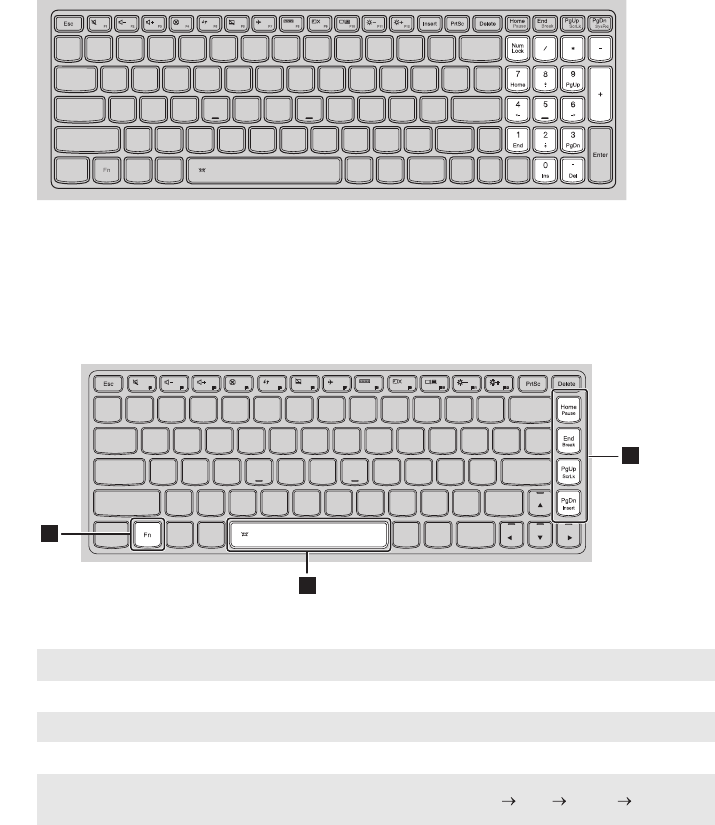
4
Chapter 1. Getting to know your computer
Using the keyboard
Numeric keypad (Lenovo FLEX 3-1580)
The keyboard has a separate numeric keypad. To enable or disable the numeric keypad, press
the Num Lock key.
Function key combinations
Through the use of the function keys, you can change operational features instantly. To use this
function, press and hold Fn ; then press one of the function keys .
Lenovo FLEX 3-1480
The following describes the features of each function key.
Fn + Home: Activates the pause function.
Fn + End: Activates the break function.
Fn + PgUp: Enables/disables the scroll lock.
Fn + PgDn: Activates the insert function.
Fn + Space
(on select models): Adjusts the keyboard backlight (off dim bright off).
a
b
1
2
2
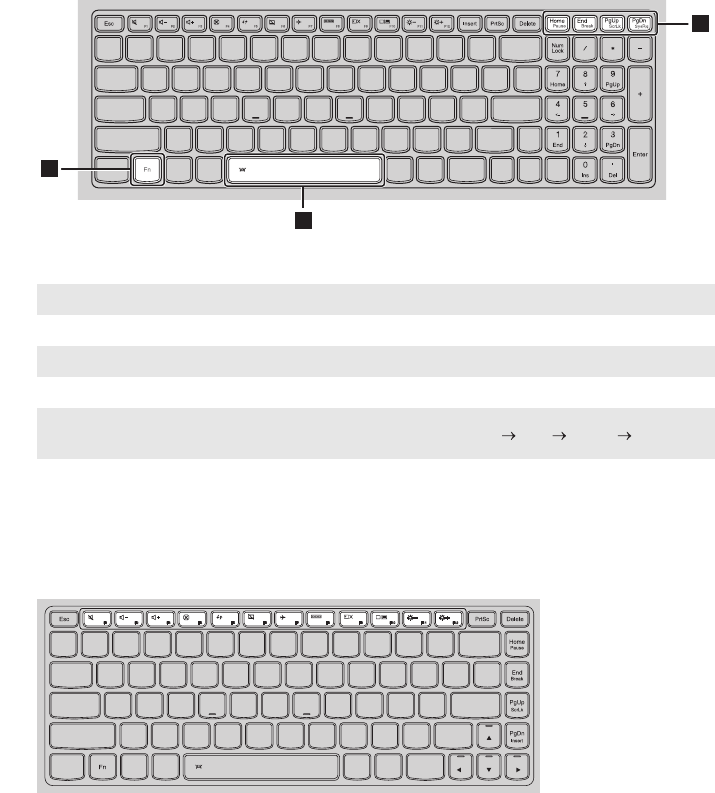
Chapter 1. Getting to know your computer
5
Lenovo FLEX 3-1580
The following describes the features of each function key.
Hotkeys
You can access certain system settings quickly by pressing the appropriate hotkeys.
Lenovo FLEX 3-1480
Fn + Home: Activates the pause function.
Fn + End: Activates the break function.
Fn + PgUp: Enables/disables the scroll lock.
Fn + PgDn: Activates the system request.
Fn + Space
(on select models): Adjusts the keyboard backlight (off dim bright off).
1
2
2
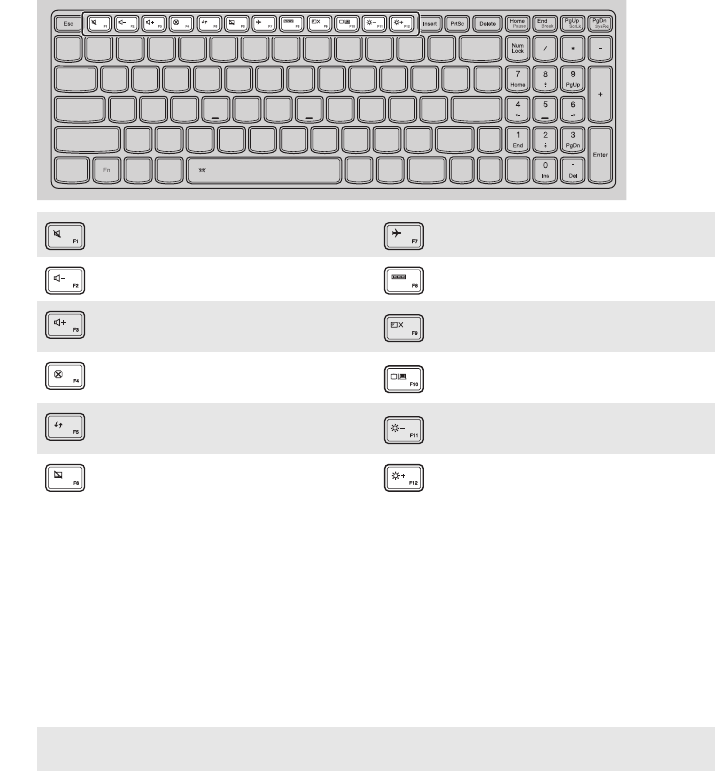
6
Chapter 1. Getting to know your computer
Lenovo FLEX 3-1580
Setting hotkey mode
By default, the hotkey functions are accessible by pressing the appropriate hotkey. However,
you can disable the hotkey mode in the BIOS setup utility.
To disable the hotkey mode:
1Shut down the computer.
2Press the Novo button and then select BIOS Setup.
3In the BIOS setup utility, open the Configuration menu, and change the setting of HotKey
Mode from Enabled to Disabled.
4Open the Exit menu, and select Exit Saving Changes.
:Mutes/unmutes the sound. :Enables/disables Airplane mode.
: Decreases the volume level. : Displays all currently active apps.
:Increases the volume level. :Turns on/off the backlight of the
LCD screen.
:
Closes the currently active window.
:Toggles the display between the
computer and an external device.
:Refreshes the desktop or the
currently active window. :Decreases the display brightness.
: Enables/disables the touchpad. : Increases the display brightness.
Note: When hotkey mode is disabled, press the Fn key and the appropriate hotkey to access the
corresponding hotkey function.
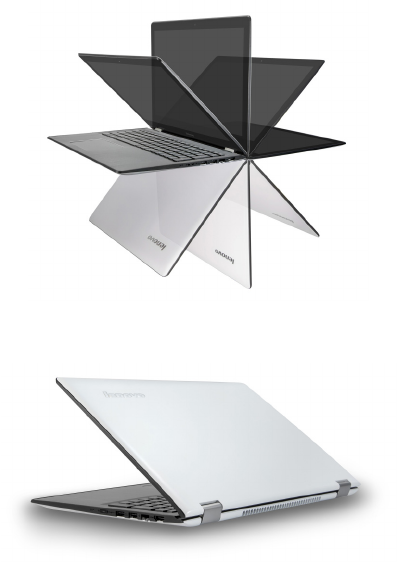
Chapter 1. Getting to know your computer
7
Positioning the display panel
The display panel can be opened to any angle up to 360 degrees.
Notebook Mode
Suitable for tasks that require a keyboard and mouse (such as creating documents, writing
e-mails, and so on).
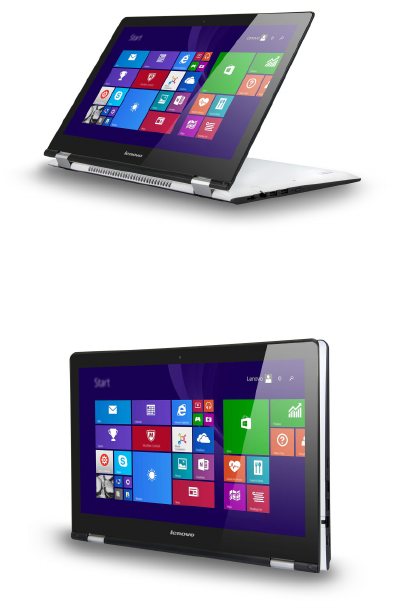
8
Chapter 1. Getting to know your computer
Stand Mode (Theater Mode)
Suitable for tasks that require little or no touch (such as viewing photos or playing videos).
Tablet Mode
Suitable for tasks that require touching the screen often (such as surfing the Web, playing games,
and so on).
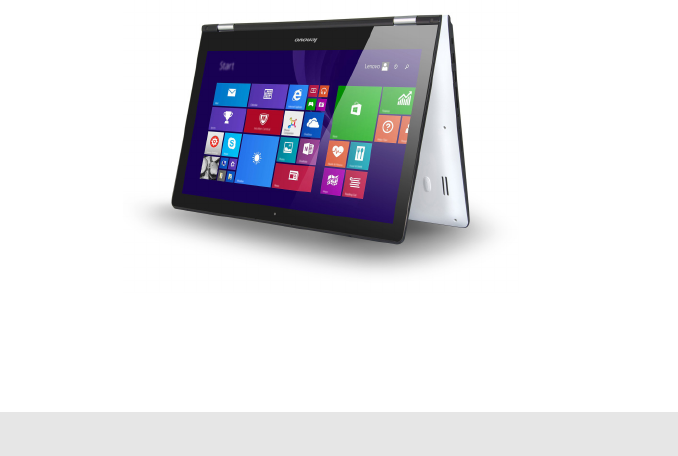
Chapter 1. Getting to know your computer
9
Tent Mode (Presentation Mode)
Suitable for tasks that require limited interaction with the touch screen (such as displaying
graphs or PowerPoint presentations).
Attention:
•Do not open the display with too much force, otherwise the panel or hinges may be damaged.
Note: The keyboard and touchpad are automatically locked when the screen is opened beyond 190 degrees
(approximately).
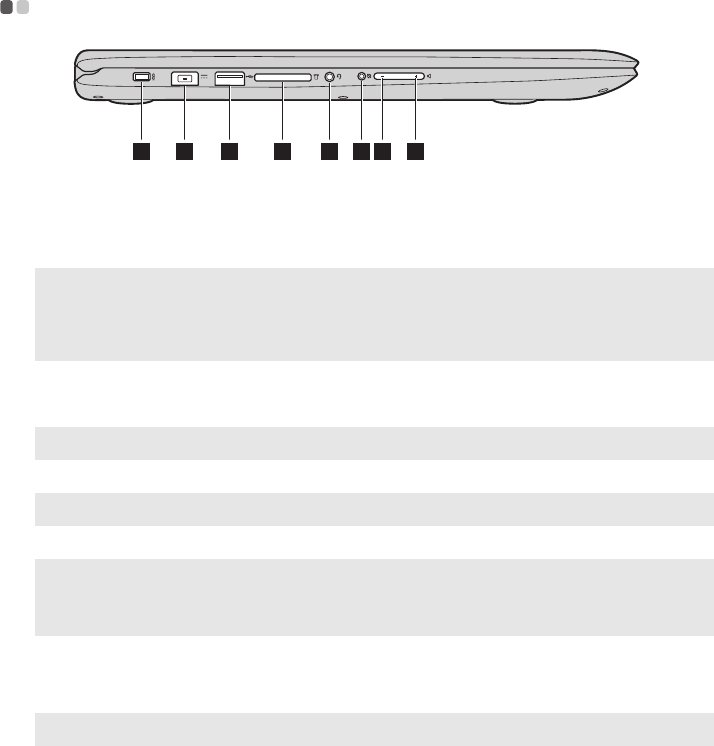
10
Chapter 1. Getting to know your computer
Left-side view - - - - - - - - - - - - - - - - - - - - - - - - - - - - - - - - - - - - - - - - - - - - - - - - - - - - - - - - - - - - - - - - - - - - - - - - - - - - - - - - - - - - - - - - - - - - - - - - - - - - - - - - - - - - - -
aKensington lock slot Attach a security lock (not supplied) here to help protect your computer
from theft and unauthorized use. You can attach a security lock to your
computer to help prevent it from being removed without your
permission. For details on installing the security lock, please refer to the
instructions shipped with the security lock that you have purchased.
Notes:
•Before purchasing any security product, verify that it is compatible with this type of security keyhole.
•You are responsible for evaluating, selecting, and implementing the locking devices and security
features. Lenovo offers no comment, judgment, or warranty regarding the function, quality, or
performance of locking devices and security features.
bAC power adapter jack Connects to the AC power adapter.
cUSB port Connects to USB devices.
Note: For details, see “Connecting USB device” on page 14.
dMemory card slot Insert memory cards (not supplied) here.
Note: For details, see “Using memory cards (not supplied)” on page 11.
eCombo audio jack Connects to headsets.
Notes:
•The combo audio jack does not support conventional microphones.
•The recording function might not be supported if third-party headphones or headsets are connected,
due to different industry standards.
fRotation lock button Keeps the screen locked in portrait or landscape orientation. Locking the
screen rotation will disable the gravity sensing function, thereby
preventing the screen from changing its orientation automatically
depending upon the angle at which it is held.
Note: The screen rotation lock button will be disabled in notebook mode.
gVolume down button Decreases the volume level.
hVolume up button Increases the volume level.
1 2 3 54 6 7 8

Chapter 1. Getting to know your computer
11
Using memory cards (not supplied)
Your computer supports the following types of memory cards:
• Secure Digital (SD) card
• Secure Digital High Capacity (SDHC) card
• Secure Digital eXtended Capacity (SDXC) card
• MultiMediaCard (MMC)
Inserting a memory card
Insert the memory card until it touches the bottom of the slot.
Removing a memory card
Gently pull the memory card out of the memory card slot.
Notes:
•Insert only one card in the slot at a time.
•This card reader does not support SDIO devices (e.g., SDIO Bluetooth, etc.).
Note: Before removing the memory card, disable it by using the Windows safely remove hardware and eject
media utility to avoid data corruption.
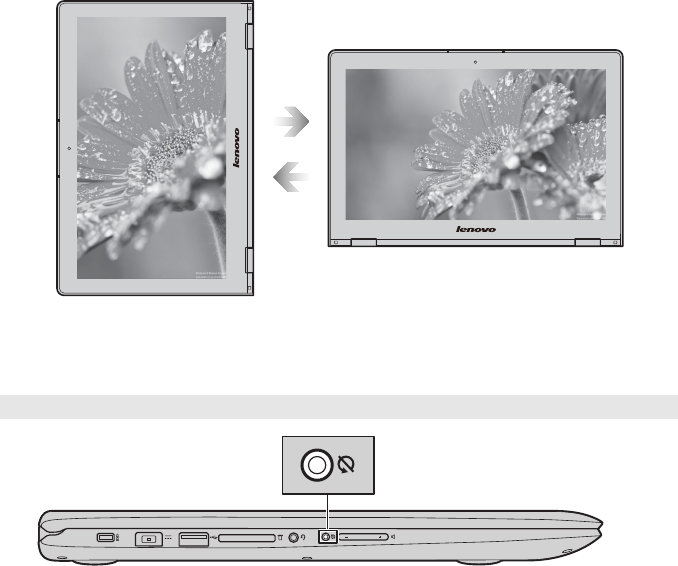
12
Chapter 1. Getting to know your computer
Screen orientation
You can rotate the display panel to your preferred orientation.
• The orientation of the display automatically changes (alternating between portrait and
landscape modes) depending on how you hold it.
• To prevent automatic orientation, press the rotation lock button. It is located on the left edge
of the computer (See illustration below).
Portrait
Landscape
Note: The screen rotation lock button will be disabled in notebook mode.
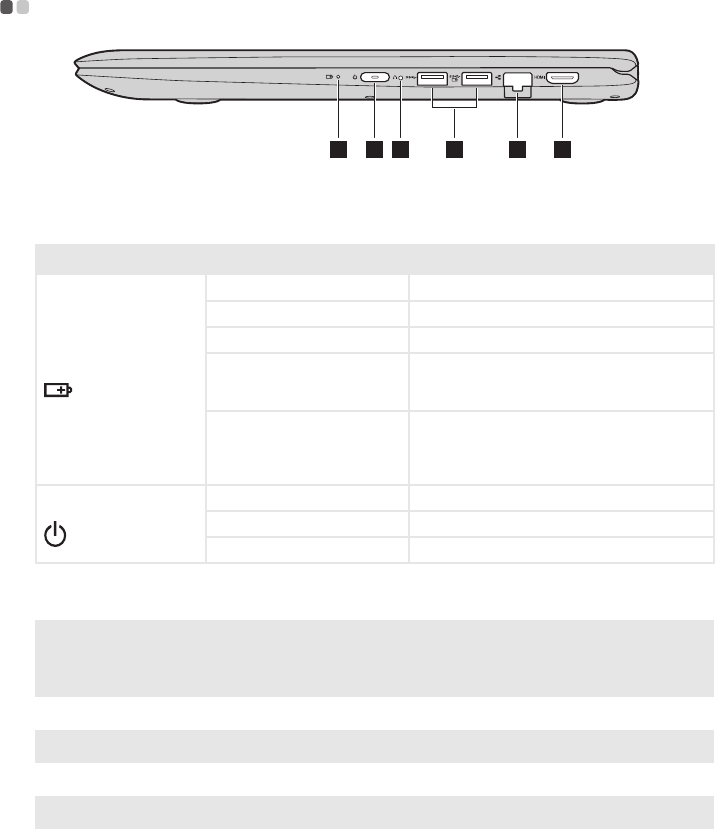
Chapter 1. Getting to know your computer
13
Right-side view - - - - - - - - - - - - - - - - - - - - - - - - - - - - - - - - - - - - - - - - - - - - - - - - - - - - - - - - - - - - - - - - - - - - - - - - - - - - - - - - - - - - - - - - - - - - - - - - - - - - - - - - - -
aBattery status indicator
bPower button Press this button to turn on the computer.
Indicator Indicator status Meaning
Battery status indicator
On (solid white) The battery has more than 20% charge.
On (solid amber) The battery has between 5% and 20% charge.
Blinking quickly (amber) The battery has less than 5% charge.
Blinking slowly (amber)
The battery is being charged. When the battery
charge reaches 20%, the blinking color will
change to white.
Blinking slowly (white)
The battery has between 20% and 80% charge and
is still charging. When the battery reaches 80%
charge the light will stop blinking, but charging
will continue until the battery is fully charged.
Power status indicator On (solid white) The computer is powered on.
Blinking The computer is in sleep mode.
Off The computer is powered off.
cNovo button When the computer is off, press this button to start the Lenovo OneKey
Recovery System or the BIOS setup utility, or to enter the boot menu.
Notes:
•You can use the tip of an unfolded paper clip (or similar object without a sharp tip) to gently press the
Novo button.
•For details, see “Lenovo OneKey Recovery System” on page 18.
dUSB port Connects to USB 3.0 devices.
Note: For details, see “Connecting USB device” on page 14.
eRJ-45 port Connects the computer to an Ethernet network.
Note: For details, see “Connecting network cables” on page 15.
fHDMI port Connects to devices with HDMI input such as a TV or an external display.
1 2 3 5 64
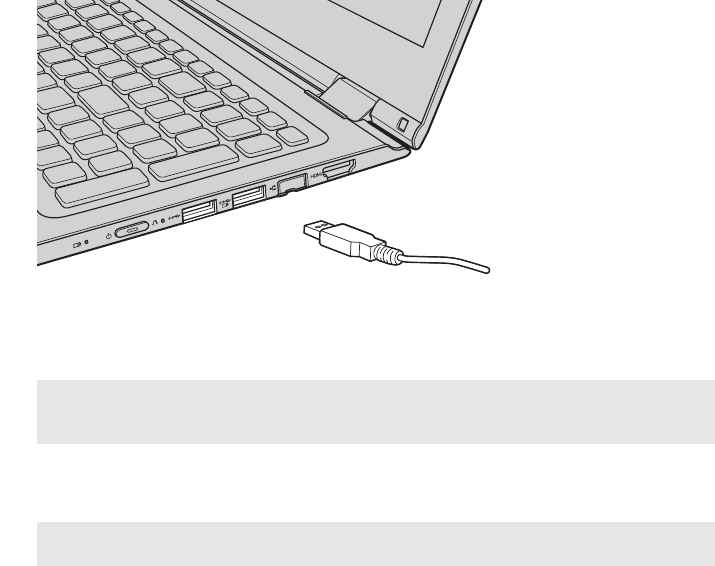
14
Chapter 1. Getting to know your computer
Connecting USB device
Your computer comes with three USB ports compatible with USB devices.
The first time you plug a USB device into a particular USB port on your computer, Windows
automatically installs a driver for that device. After the driver has been installed, you can
disconnect and reconnect the device without performing any additional steps.
Before disconnecting a USB storage device, make sure your computer has finished transferring
data to that device. Click the Safely Remove Hardware and Eject Media icon in the Windows
notification area to remove the device before disconnecting.
Note: Typically, Windows detects a new device after it has been connected, and then installs the driver
automatically. However, some devices may require you to install the driver before connecting. Check
the documentation provided by the device’s manufacturer before connecting the device.
Note: If your USB device uses a power cord, connect the device to a power source before connecting it.
Otherwise, the device may not be recognized.
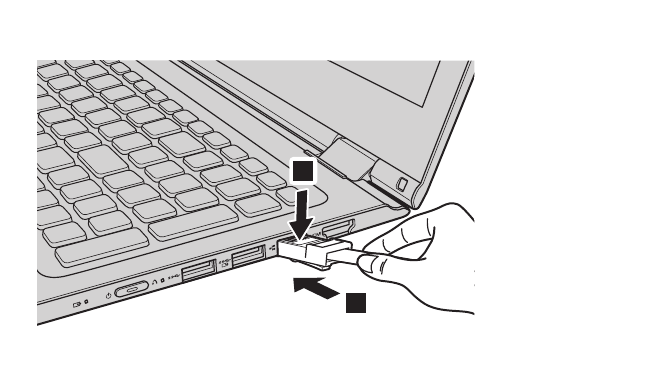
Chapter 1. Getting to know your computer
15
Connecting network cables
To insert a network cable, do the following:
1Hold one connector of the network cable to press the RJ-45 cover down gently .
2Insert the connector into the RJ-45 port .
Software configuration
Consult your Internet Service Provider (ISP) for details on how to configure your computer.
a
b
1
2
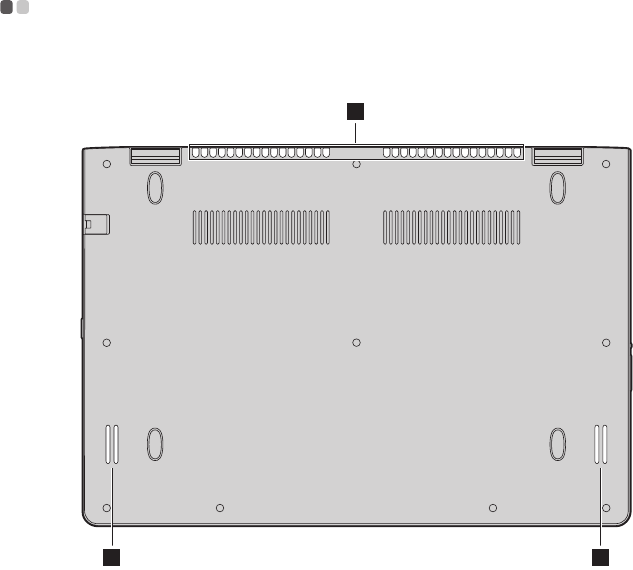
16
Chapter 1. Getting to know your computer
Bottom view - - - - - - - - - - - - - - - - - - - - - - - - - - - - - - - - - - - - - - - - - - - - - - - - - - - - - - - - - - - - - - - - - - - - - - - - - - - - - - - - - - - - - - - - - - - - - - - - - - - - - - - - - - - - - - - - - -
Lenovo FLEX 3-1480
1
22
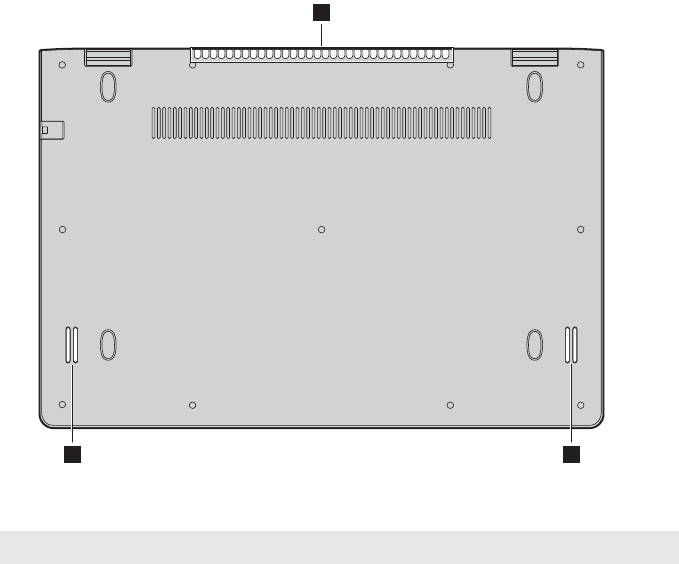
Chapter 1. Getting to know your computer
17
Lenovo FLEX 3-1580
aVentilation slots Dissipate internal heat.
Note: Make sure that the ventilation slots are not blocked or else the computer may overheat.
bSpeakers Provide audio output.
1
22

18
Chapter 2. Lenovo OneKey Recovery System
The Lenovo OneKey Recovery System is software designed to back up and restore your
computer. You can use it to restore the system partition to its original status in case of a system
failure. You can also create user backups for easy restoration as required.
Backing up the system partition
You can back up the system partition to an image file. This image file can be used to restore the
system partition. To back up the system partition:
1In Windows, press the Novo button or double-click OneKey Recovery icon to start the
Lenovo OneKey Recovery System.
2Click System Backup.
3Select a back-up location and click Next to start the backup.
Restoring
You can choose to restore the system partition to its original status or to a previously created
back-up point. To restore the system partition:
1In Windows, press the Novo button or double-click OneKey Recovery icon to start the
Lenovo OneKey Recovery System.
2Click System Recovery. The computer will restart to the recovery environment.
3Follow the on-screen instructions to restore the system partition to its original status or to a
previously created back-up point.
If Windows cannot be started, then follow the steps below to start the Lenovo OneKey
Recovery System:
1Shut down the computer.
2Press the Novo button. From Novo Button Menu, select System Recovery and press Enter.
Notes:
•If your computer is preinstalled with a GNU/Linux operating system, OneKey Recovery System is
not available.
•To utilize the features of the OneKey Recovery System, your hard disk already includes a hidden
partition by default to store the system image file and the OneKey Recovery System program files. This
default partition is hidden for security reasons, which explains why the available disk space is less than
the stated capacity.
Notes:
•You can choose a back-up location on the local hard disk drive or an external storage device.
•Remove the removable hard disk drive before starting the Lenovo OneKey Recovery System. Otherwise,
data from the removable hard disk drive might be lost.
•The back-up process may take a while.
•The back-up process is only available when Windows can be started normally.
Notes:
•The recovery process is irreversible. Make sure to back up any data you wish to save on the system
partition before starting the recovery process.
•The recovery process may take a while. So be sure to connect the AC power adapter to your computer
during the recovery process.
•The above instructions should be followed when Windows can be started normally.

19
Chapter 3. Troubleshooting
Frequently asked questions - - - - - - - - - - - - - - - - - - - - - - - - - - - - - - - - - - - - - - - - - - - - - - - - - - - - - - - - - - - - - - - - - - - - - - - - - - -
This section lists frequently asked questions by category.
Finding information
Drivers and preinstalled software
Lenovo OneKey Recovery System
What safety precautions should I follow when using my computer?
The Lenovo
Safety and General Information Guide
which came with your computer contains safety
precautions for using your computer. Read and follow all the precautions when using your computer.
Where can I find the hardware specifications for my computer?
You can find the hardware specification for your computer on the printed flyers which came
with your computer.
Where can I find warranty information?
For detailed warranty information on this machine, please visit below website to check out:
support.lenovo.com/warrantystatus.
Where are the installation discs for Lenovo preinstalled software (desktop software)?
Your computer did not come with installation discs for Lenovo preinstalled software. If you
need to reinstall any preinstalled software, you can find the installation program on the D
partition of your hard disk. If you cannot find the installation program there, you can also
download it from the Lenovo consumer support website.
Where can I find drivers for the various hardware devices of my computer?
If your computer is preinstalled with a Windows operating system, Lenovo provides drivers for
all the hardware devices that you need on the D partition of your hard disk. You can also
download the latest device drivers from the Lenovo consumer support website.
Where are the recovery discs?
Your computer did not come with any recovery discs. Use the Lenovo OneKey Recovery System
if you need to restore the system to its original factory status.
What can I do if the back-up process fails?
If you can start the backup but it fails during the back-up process, try the following steps:
1Close all open programs, and then restart the back-up process.
2Check to see if the destination media is damaged. Select another path and then try again.
When do I need to restore the system to its factory status?
Use this feature when the operating system fails to start up. If there is critical data on the system
partition, back it up before starting recovery.
20
Chapter 3. Troubleshooting
BIOS setup utility
Getting help
What is the BIOS setup utility?
The BIOS setup utility is a ROM-based software. It displays basic computer information and
provides options for setting boot devices, security, hardware mode, and other preferences.
How can I start the BIOS setup utility?
To start the BIOS setup utility:
1Shut down the computer.
2Press the Novo button and then select BIOS Setup.
How can I change the boot mode?
There are two boot modes: UEFI and Legacy Support. To change the boot mode, start the BIOS
setup utility and set boot mode to UEFI or Legacy Support on the boot menu.
When do I need to change the boot mode?
The default boot mode for your computer is UEFI mode. If you need to install a legacy operating
system, such as Windows, Linux or Dos, etc (that is, any operating system before Windows 8) on
your computer, you must change the boot mode to Legacy Support. The legacy operating system,
such as Windows, Linux or Dos, etc cannot be installed if you don't change the boot mode.
How can I contact the customer support center?
See “Chapter 3. Getting help and service” in the Lenovo Safety and General Information Guide.

Chapter 3. Troubleshooting
21
Troubleshooting - - - - - - - - - - - - - - - - - - - - - - - - - - - - - - - - - - - - - - - - - - - - - - - - - - - - - - - - - - - - - - - - - - - - - - - - - - - - - - - - - - - - - - - - - - - - - - - - - - - - - - -
Display problems
When I turn on the
computer, nothing appears
on the screen.
•If the screen is blank, make sure that:
- The AC power adapter is connected to the computer, and
the power cord is plugged into a working electrical outlet.
- The computer power is on. Press the Power button again
for confirmation.
•If these items are properly set, and the screen remains blank,
have the computer serviced.
When I turn on the
computer, only a white
cursor appears on a
blank screen.
•Restore backed-up files to your Windows environment or the
entire contents of your hard disk to its original factory contents
using the Lenovo OneKey Recovery System. If you still see
only the cursor on the screen, have the computer serviced.
The screen goes blank
while the computer is on.
•Your screen saver or power management may be enabled. Do
one of the following to resume from sleep mode:
- Press any key on the keyboard. (Notebook mode only)
-Press the Power button.
-Press F9 ( ) to confirm whether the backlight of the
LCD screen has been turned off.
Sleep problems
The critical low-battery
error message appears,
and the computer
immediately turns off.
•The battery power is getting low. Connect the AC power
adapter to the computer.
The computer enters sleep
mode immediately after
Power-on self-test (POST).
•Make sure that:
- The battery pack is charged.
- The operating temperature is within the acceptable range.
See “Chapter 2. Use and care Information” in the Lenovo
Safety and General Information Guide.
Note: If the battery pack is charged and the temperature is within range, have the computer serviced.
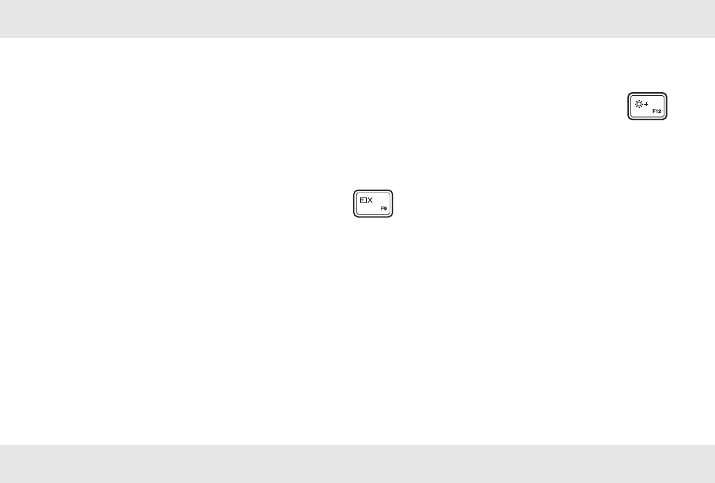
22
Chapter 3. Troubleshooting
The computer does not
return from sleep mode,
and the computer
does not work.
•If your computer is in sleep mode, connect the AC power
adapter to the computer, then press the Power button.
•If the system still does not return from sleep mode, stops
responding, or cannot be turned off, reset the computer.
Unsaved data may be lost. To reset the computer, press and
hold the Power button for five seconds or more. If the
computer is still not reset, remove the AC power adapter.
Display panel problems
The screen is blank. •Do the following:
- If you are using the AC power adapter or the battery pack,
and the battery status indicator is on, press F12 ( ) to
make the screen brighter.
- If the power indicator is blinking, press the Power button to
resume from sleep mode.
-Press F9 ( ) to confirm whether the backlight of the
LCD screen has been turned off.
- If the problem persists, follow the solution in the next
problem “The screen is unreadable or distorted.”
The screen is unreadable
or distorted.
•Make sure that:
- The screen resolution and color quality are correctly set.
- The monitor type is correct.
Incorrect characters
appear on the screen.
•Is the operating system or programs installed correctly? If
they are installed and configured correctly, have the
computer serviced.
Sound problems
No sound can be heard
from the speakers even
when the volume is
turned up.
•Make sure that:
- The Mute function is off.
- The combo audio jack is not being used.
- Speakers are selected as the playback device.

Chapter 3. Troubleshooting
23
Battery pack problems
Your computer shuts down
before the battery status
indicator shows empty.
-or-
Your computer operates
after the battery status
indicator shows empty.
•Recharge the battery.
Other problems
Your computer does
not respond.
•To turn off your computer, press and hold the Power button
for five seconds or more. If the computer still does not
respond, remove the AC power adapter.
•Your computer might lock when it enters sleep mode during
a communication operation. Disable the sleep timer when
you are working on the network.
The connected external
device does not work.
•Do not connect or disconnect any external device cables other
than USB while the computer power is on. Otherwise, you
might damage your computer.
•When using high power consumption external devices such
as an external USB optical disk drive, use an external device
power adapter. Otherwise, the device may not be recognized,
or the system may shut down as a result.
24
Trademarks
The following terms are trademarks or registered trademarks of Lenovo in the United States,
other countries, or both.
Lenovo
OneKey
Microsoft and Windows are trademarks of Microsoft Corporation in the United States, other
countries, or both.
Other company, products, or service names may be trademarks or service marks of others.
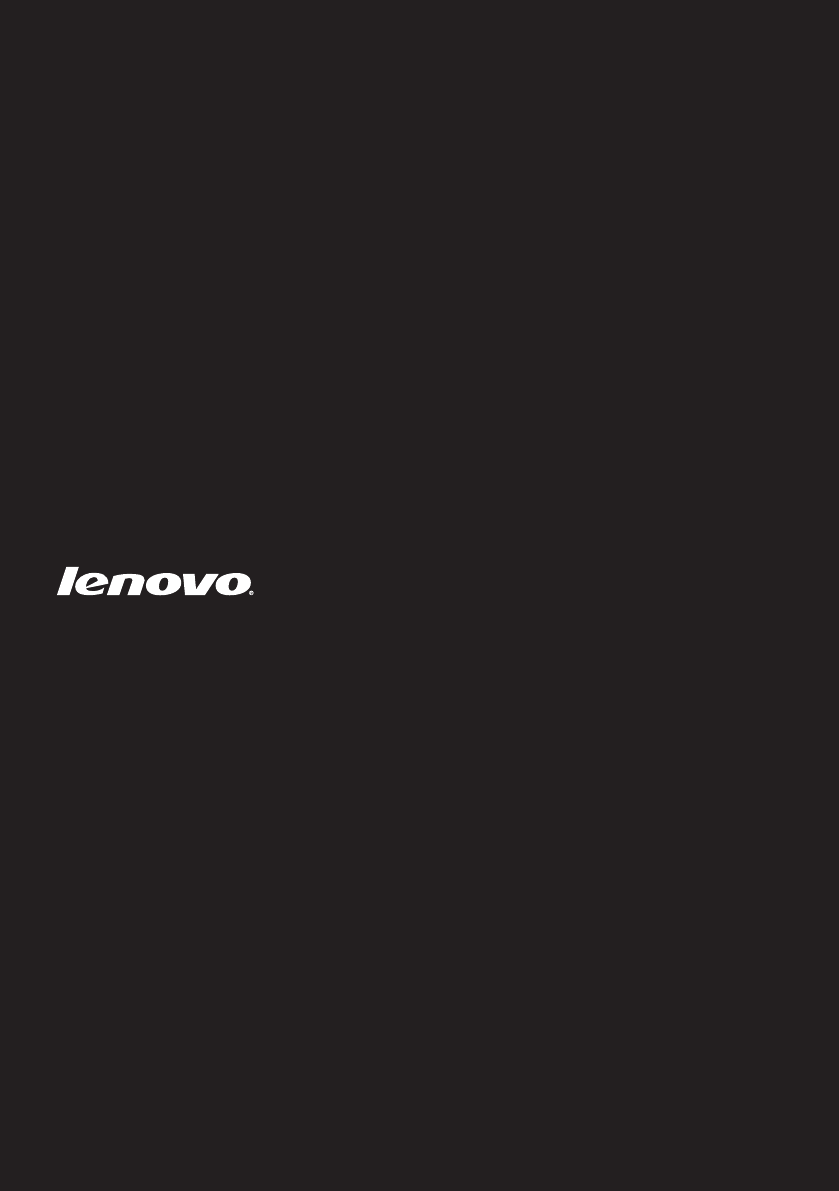
en-US
Rev. AA00
©Lenovo China 2015